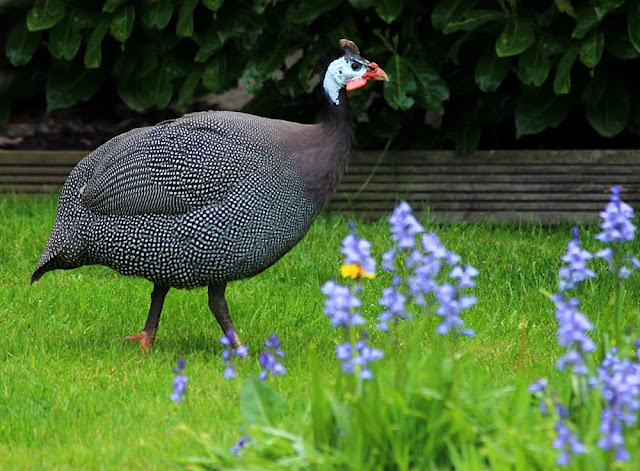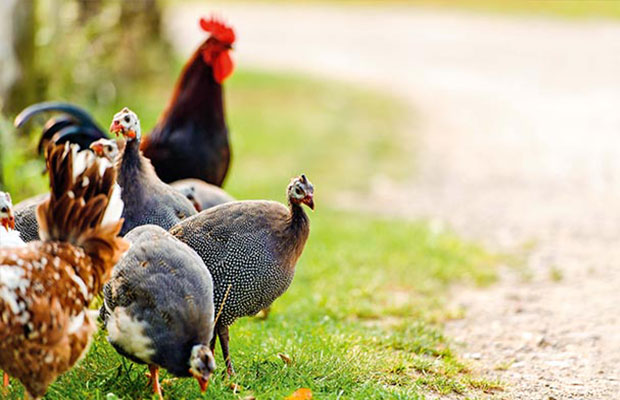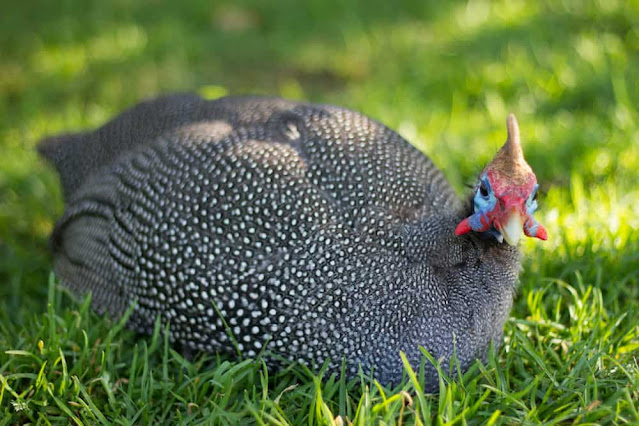Guinea fowl, any of a family, Numididae (order Galliformes), of African birds that are alternatively placed by some authorities in the Pheasant family, Phasianidae. The family consists of 7–10 species, one of which, Numida meleagris, is widely domesticated for its flesh and as a “watchdog” on farms (it gabbles loudly at the least alarm). The largest and most-colourful species is the Vulturin guinea fowl (Acryllium vulturinum), of Eastern Africa, a long-necked bird with a hackle of long lance-shaped feathers striped black, white, and blue; red eyes; and a vulturelike bare blue head.
ORIGIN AND DISTRIBUTION
The guinea fowl is descended from the wild species of
Africa. The fowls derive their name from Guinea, part of the west coast of
Africa. As already mentioned guinea fowls (Numida meleagris) are indigenous to
Africa, but they were brought to Europe during middle ages. In Africa, guineas
are hunted as game birds; and in England they are sometimes used to stock game
preserves. Guineas have been domesticated for many centuries; ancient Greeks
and Romans raised them for table birds. To date, guineas are ubiquitous. It is
believed that they might be more popular were it not for their harsh and
seemingly never-ending cry, and their narrow disposition.
Feeding
Keeps should be fed on turkey or game bird feed as these
meet their protein requirements. They can be given starter crumbs until 6
weeks, then grower pellets until around 10 weeks, or until slaughter for meat
birds. After this the adult birds will be fine on ordinary layers pellets,
supplemented with some greens. You may well find that free-ranging guinea fowl
forage most of their own food and only need supplemental feeding in the winter.
It’s possible to buy organic and/or soya-free compound feeds, but you can also mix your own feeds using ingredients such as seeds, grains and meal worms. This is particularly worth considering if your birds are foraging a large part of their diet, so you’re not trying to meet all of their nutritional needs. Mixing your own feed can allow you to choose more sustainable ingredients and save money. As with most poultry, guinea fowl should have access to fresh water and grit at all times, and layers should have a source of calcium (e.g. oyster shell).
Guinea fowl protect your hens
If you want to house Guinea Fowl with your hens, they must
all be raised together from a young age. If you simply put adult Guinea Fowl in
with your chooks, fighting will occur, and your chooks will lose. However, if
your farm has room for the Guinea Fowl to roam and live outside the coop and
run, they will help protect the coop from predators large and small. Guinea
fowl are noisy when they spot a predator such as a wild bird, wild dog, fox or
snake. Their sheer noise is generally sufficient to let the predator know they
mean business. So if you have hens which free range on the farm or rural
backyard, Guinea fowl will alert your chooks to any danger.
These birds will happily roam in the day free grazing and
happily roost in trees at night. It is better for them however, to have a place
to roost at night safe from predators. If you already have an established
chicken coop, then you should have a sperate coop for your Guinea fowl.
Initially, keep the coop and run enclosed for a few weeks for them to get used
to their new home, after that they will know where to come home to at night.
Guineas Are Crazy Fast
If you need to catch your guineas, you can forget it. They
are fast. The only way you’ll most likely be able to catch them is if they are cooped
at night. Even then, you get only one shot. If you blow it, you won’t catch
them that night. So how do you catch them? You first have to wait until they
are cooped. Then you have to grab them by their wings. We actually use a net,
so we don’t hurt them. Guinea fowl have really delicate legs. If you grab them
by their leg, they’ll whip around on you and actually break it. That is why it
is best to grab them by their wings or just use a net and catch the whole bird
at once. When you have to catch them be prepared to laugh at yourself. It gets
humorous quickly.
Guinea Health
Guinea fowl are very low maintenance compared to poultry.
Guineas seldom get sick. Also, they rarely succumb to the flock diseases that
hens do. So not only do they help keep the ticks, mites and other insects at
bay but they don't cost you the earth in vet fees. Win, Win. Overall, Guinea
fowl can be very entertaining. You can make an afternoon just watching how
ridiculous they can be as they forage around. And, if you can live the noise,
keep the neighbours happy and protect your car paint, we think they are a great
addition to your backyard flock in a rural area.
Housing
Convincing your guinea fowl to use their house at all may be
your first problem! You’re most likely to have success if your provide them
with a high place to roost. Depending on numbers this may be high perches in a
large shed, or a smaller ‘loft’-type house raised off the ground. The higher
the roosting place you provide, the more likely they are to use it. Guineas will
fly vertically upwards onto perches, and you can place intermediate perches
lower down to enable them to reach the high ones. Other than this their house
needs to be dry and draught-proof. It should also have a wide entrance, or
multiple entrances, otherwise submissive guineas may be reluctant to enter and
will try to roost elsewhere. Guineas don’t require nest boxes – they’d rather
hide their eggs in the dense undergrowth for you to hunt for!
Share with Your Friends..
Reference:
https://www.britannica.com/animal/guinea-fowl
https://www.lowimpact.org/lowimpact-topic/guinea-fowl/
https://morningchores.com/about-guinea-fowl/
https://www.dineachook.com.au/blog/why-guinea-fowl-are-the-best-pest-control/

















No comments:
Post a Comment